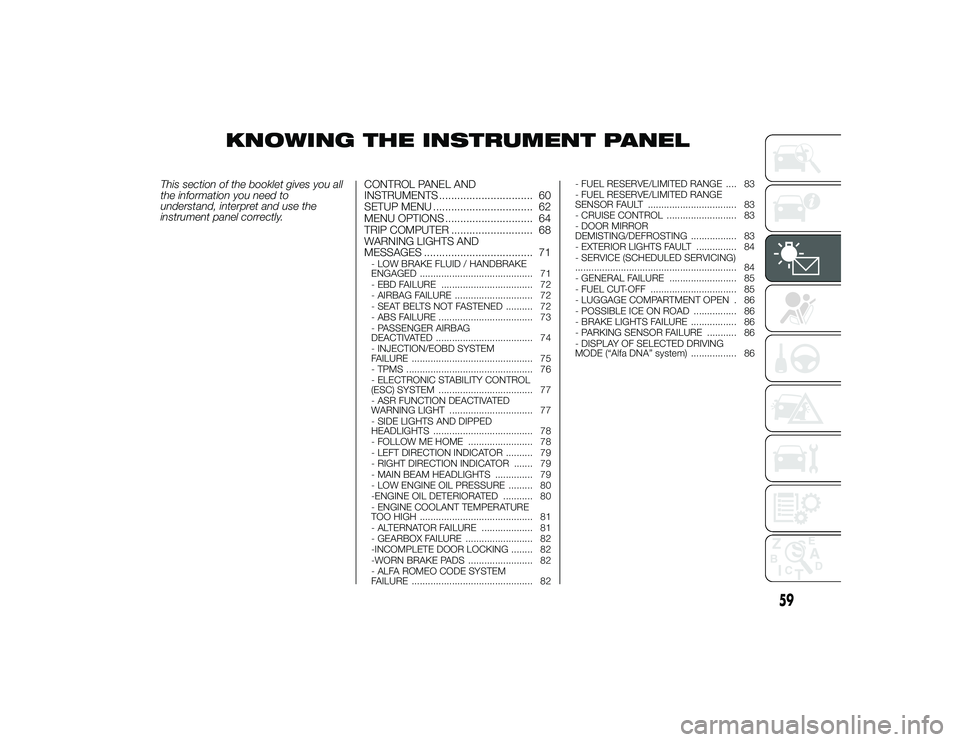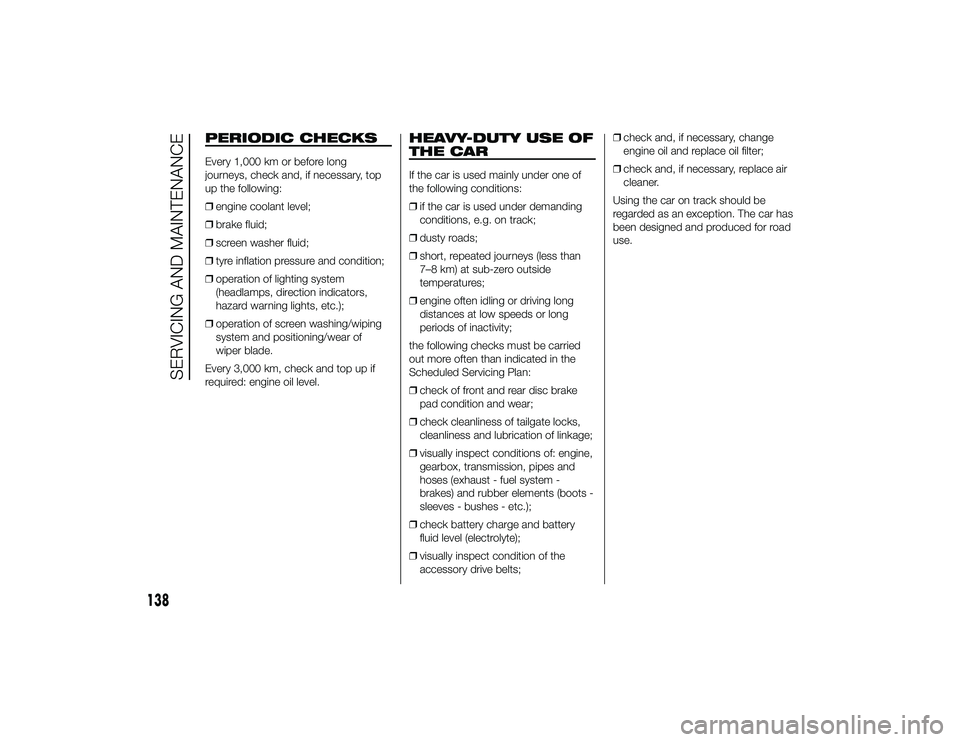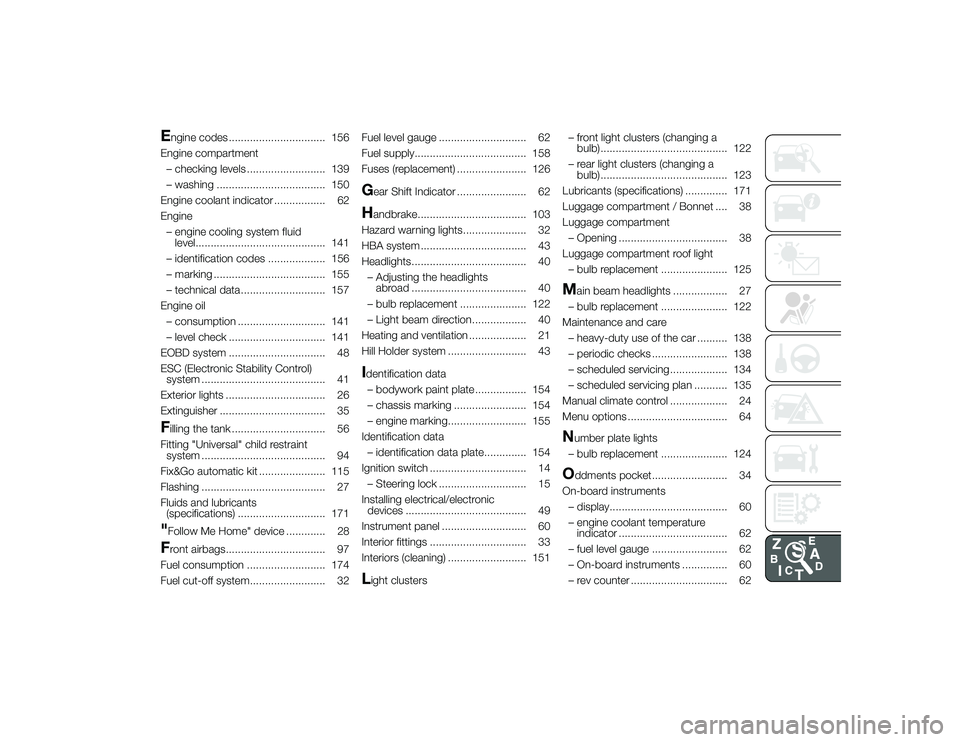engine coolant Alfa Romeo 4C 2014 Owner handbook (in English)
[x] Cancel search | Manufacturer: ALFA ROMEO, Model Year: 2014, Model line: 4C, Model: Alfa Romeo 4C 2014Pages: 190, PDF Size: 7.87 MB
Page 62 of 190

KNOWING THE INSTRUMENT PANEL
This section of the booklet gives you all
the information you need to
understand, interpret and use the
instrument panel correctly.CONTROL PANEL AND
INSTRUMENTS ............................... 60
SETUP MENU ................................. 62
MENU OPTIONS ............................. 64
TRIP COMPUTER ........................... 68
WARNING LIGHTS AND
MESSAGES .................................... 71
- LOW BRAKE FLUID / HANDBRAKE
ENGAGED .......................................... 71
- EBD FAILURE .................................. 72
- AIRBAG FAILURE ............................. 72
- SEAT BELTS NOT FASTENED .......... 72
- ABS FAILURE ................................... 73
- PASSENGER AIRBAG
DEACTIVATED .................................... 74
- INJECTION/EOBD SYSTEM
FAILURE ............................................. 75
- TPMS ............................................... 76
- ELECTRONIC STABILITY CONTROL
(ESC) SYSTEM ................................... 77
- ASR FUNCTION DEACTIVATED
WARNING LIGHT ............................... 77
- SIDE LIGHTS AND DIPPED
HEADLIGHTS ..................................... 78
- FOLLOW ME HOME ........................ 78
- LEFT DIRECTION INDICATOR .......... 79
- RIGHT DIRECTION INDICATOR ....... 79
- MAIN BEAM HEADLIGHTS .............. 79
- LOW ENGINE OIL PRESSURE ......... 80
-ENGINE OIL DETERIORATED ........... 80
- ENGINE COOLANT TEMPERATURE
TOO HIGH .......................................... 81
- ALTERNATOR FAILURE ................... 81
- GEARBOX FAILURE ......................... 82
-INCOMPLETE DOOR LOCKING ........ 82
-WORN BRAKE PADS ........................ 82
- ALFA ROMEO CODE SYSTEM
FAILURE ............................................. 82 - FUEL RESERVE/LIMITED RANGE .... 83
- FUEL RESERVE/LIMITED RANGE
SENSOR FAULT ................................. 83
- CRUISE CONTROL .......................... 83
- DOOR MIRROR
DEMISTING/DEFROSTING ................. 83
- EXTERIOR LIGHTS FAULT ............... 84
- SERVICE (SCHEDULED SERVICING)
............................................................ 84
- GENERAL FAILURE ......................... 85
- FUEL CUT-OFF ................................ 85
- LUGGAGE COMPARTMENT OPEN . 86
- POSSIBLE ICE ON ROAD ................ 86
- BRAKE LIGHTS FAILURE ................. 86
- PARKING SENSOR FAILURE ........... 86
- DISPLAY OF SELECTED DRIVING
MODE (“Alfa DNA” system) ................. 86
59
24-9-2013 11:49 Pagina 59
Page 63 of 190

CONTROL PANEL AND INSTRUMENTS
.
Display with metric unitsA. Engine coolant temperature indicator – B. Time – C. Rev counter – D. Mode/gear engaged indicator – E. Gear change suggestion (Gear Shift
Indicator) – F. Outside temperature – G. Fuel level gauge (the triangle on the right side of the
symbol indicates the side of the car with the fuel
filler) – H. Area dedicated to the display of the digital warning light related to the displayed message – I. Trip milometer – J. Speedometer (Speed
indicator) – K. "Alfa DNA" system driving mode – L. Messages or information on display – M. Milometer
59
A0L0118
60
KNOWING THE INSTRUMENT PANEL
24-9-2013 11:49 Pagina 60
Page 64 of 190

Display with imperial unitsA. Engine coolant temperature indicator – B. Time – C. Rev counter – D. Mode/gear engaged indicator – E. Gear change suggestion (Gear Shift
Indicator) – F. Outside temperature – G. Fuel level gauge (the triangle on the right side of the
symbol indicates the side of the car with the fuel
filler) – H. Area dedicated to the display of the digital warning light related to the displayed message – I. Trip milometer – J. Speedometer (Speed
indicator) – K. "Alfa DNA" system driving mode – L. Messages or information on display – M. Milometer
60
A0L0129
61
24-9-2013 11:49 Pagina 61
Page 65 of 190

SPEEDOMETER (SPEED
INDICATOR)
Indicator J shows the speed of the car.
REV COUNTER
Light C shows the engine revs.
FUEL LEVEL GAUGE
Gauge G shows the amount of fuel in
the tank.
The switching on of the
digital
warning light indicates that 4–5 litres of
fuel are left in the tank; in this situation,
refuel as soon as possible.
Do not travel with the fuel tank almost
empty: any gaps in fuel delivery could
damage the catalytic converter.
ENGINE COOLANT
TEMPERATURE
INDICATOR
Indicator A shows the temperature of
the engine coolant and starts supplying
indications when the fluid temperature
exceeds approximately 50°C.
The
digital warning light may switch
on (together with a message on the
display) to indicate that the coolant
temperature is too high; in this case,
stop the engine and contact a
dedicated Alfa Romeo Dealership. GEAR SHIFT INDICATOR
The GSI (Gear Shift Indicator) system
advises the driver to change gear
through a specific indication E fig. 59
on the instrument panel.
Through the GSI, the driver is notified
that changing gear will allow a
reduction in fuel consumption.
Therefore, for driving oriented towards
reducing fuel consumption, it is
advisable to stick to “Natural” or “All
Weather” mode and to follow the
suggestions of the Gear Shift Indicator,
where traffic conditions permit.
When the (
) icon is displayed on the
instrument panel, the GSI suggests
switching to a higher gear, while when
the (
) icon is displayed, the GSI
suggests changing to a lower gear.
IMPORTANT The GSI is not active
when the transmission is operating in
AUTO mode.
IMPORTANT The indication in the
instrument panel remains on until the
driver shifts gear or the driving
conditions go back to a situation where
gearshifting is not required to improve
consumption.
SETUP MENUCONTROL BUTTONS
SET/
: press briefly to access the
menu and/or go to next screen or
confirm the selection. Hold down to
return to the standard screen fig. 61.
: to scroll up through the displayed
screen and the related options or to
increase the displayed value.: to scroll down through the
displayed menu and the related options
or to decrease the value displayed.
IMPORTANT The
and
buttons
activate different functions according to
the following situations:
❒ within the menu, they allow you to
scroll up and down through the
options;
61
A0L0125
62
KNOWING THE INSTRUMENT PANEL
24-9-2013 11:49 Pagina 62
Page 84 of 190

Warning lights ondisplay What it means
What to do
redENGINE COOLANT TEMPERATURE
TOO HIGH
The digital warning light switches on when
the key is turned to MAR-ON, but it should
switch off after a few seconds. The warning
light switches on when the engine is
overheated.
The display shows the dedicated message. When driving normally: stop the car, switch off the
engine and check that the water level in the reservoir is
not below the MIN mark. If it is, wait for the engine to
cool down then slowly and carefully open the cap, top
up with coolant and check that the level is between the
MIN and MAX marks on the reservoir. Also check
visually for any fluid leaks. Should the warning light turn
on again at the next start-up, contact the dedicated
Alfa Romeo Dealership.
If the car is used under demanding conditions (e.g. in
high-performance driving): slow down and, if the
warning light stays on, stop the car. Wait for 2 or 3
minutes with the engine running and slightly
accelerated to further favour the coolant circulation.
Then stop the engine. Check the correct coolant level
as described above.
IMPORTANT Over demanding routes, it is advisable to
keep the engine on and slightly accelerated for a few
minutes before switching it off.
Warning lights on
display What it means
What to do
redALTERNATOR FAILURE
The digital warning light switches on, only with
engine started, when an alternator fault is
detected.
Contact the dedicated Alfa Romeo Dealership as
soon as possible.
81
24-9-2013 11:49 Pagina 81
Page 105 of 190

STARTING THE
ENGINEProcedure
84) 85) 86)
❒press the brake pedal;
❒ turn the ignition key to AVV and
release it as soon as the engine
starts.
IMPORTANT INFORMATION
8) 9)
❒ If the engine does not start at the first
attempt, return the ignition key to
STOP before repeating the
procedure.
❒ If, when the ignition key is at
MAR-ON, the
instrument panel
warning light stays on together with
the
warning light, turn the key
to STOP and then back to MAR-ON;
if the warning light stays on, try the
other keys provided with the vehicle.
If it is still not possible to start the
engine, contact a dedicated Alfa
Romeo Dealership.
❒ Do not leave the ignition key at
MAR-ON when the engine is
stopped. WARMING UP THE
ENGINE JUST AFTER IT
HAS STARTED
Procedure
❒
drive off slowly, letting the engine turn
at medium revs. Do not accelerate
abruptly;
❒ do not demand full performance at
first. It is advisable to wait until the
digital engine coolant temperature
indicator starts moving.
SWITCHING OFF THE
ENGINE
Procedure
Turn the ignition key to STOP while the
engine is idling.
10)
IMPORTANT After a demanding drive,
keep the engine idling for at least a
couple of minutes before stopping it, in
order to permit the temperature inside
the engine compartment to lower.
WARNING
84) It is dangerous to run the engine in enclosed areas. The engine
takes in oxygen and releases
carbon dioxide, carbon monoxide
and other toxic gases.
85) The brake servo is not active until the engine is started, so
you would need to apply much
more force than usual to the
brake pedal.
86) Do not start the engine by pushing, towing or driving
downhill. These manoeuvres may
damage the catalytic converter.
IMPORTANT
8) It is advisable not to demandmaximum performance from your
car (e.g. excessive acceleration,
long distances at maximum rpm,
excessively intense braking, etc.)
when it is first used.
102
STARTING AND DRIVING
24-9-2013 11:50 Pagina 102
Page 141 of 190

PERIODIC CHECKSEvery 1,000 km or before long
journeys, check and, if necessary, top
up the following:
❒engine coolant level;
❒ brake fluid;
❒ screen washer fluid;
❒ tyre inflation pressure and condition;
❒ operation of lighting system
(headlamps, direction indicators,
hazard warning lights, etc.);
❒ operation of screen washing/wiping
system and positioning/wear of
wiper blade.
Every 3,000 km, check and top up if
required: engine oil level.
HEAVY-DUTY USE OF
THE CARIf the car is used mainly under one of
the following conditions:
❒ if the car is used under demanding
conditions, e.g. on track;
❒ dusty roads;
❒ short, repeated journeys (less than
7–8 km) at sub-zero outside
temperatures;
❒ engine often idling or driving long
distances at low speeds or long
periods of inactivity;
the following checks must be carried
out more often than indicated in the
Scheduled Servicing Plan:
❒ check of front and rear disc brake
pad condition and wear;
❒ check cleanliness of tailgate locks,
cleanliness and lubrication of linkage;
❒ visually inspect conditions of: engine,
gearbox, transmission, pipes and
hoses (exhaust - fuel system -
brakes) and rubber elements (boots -
sleeves - bushes - etc.);
❒ check battery charge and battery
fluid level (electrolyte);
❒ visually inspect condition of the
accessory drive belts; ❒
check and, if necessary, change
engine oil and replace oil filter;
❒ check and, if necessary, replace air
cleaner.
Using the car on track should be
regarded as an exception. The car has
been designed and produced for road
use.
138
SERVICING AND MAINTENANCE
24-9-2013 11:50 Pagina 138
Page 142 of 190

CHECKING LEVELS.The topping-up plug B and the dipstick A for checking the engine oil level and the reservoir C for the engine coolant can be
accessed by lifting the tailgate (see the procedure in the "Bonnet/Luggage Compartment" paragraph in the "Knowing your car"
chapter).
19)113) 114) 115)110
A0L0152
139
24-9-2013 11:50 Pagina 139
Page 144 of 190

ENGINE OIL
Check that the oil level is between the
MIN and MAX marks on the dipstick
A fig. 110.
For this check, take out the dipstick
from its seat, clean it with a lint-free
cloth, reinsert the dipstick; take it out
again and check the oil level.
116)
If the oil level is near or under the MIN
mark, add oil through the filler B fig.
110 until it reaches the MAX mark.
20)
Take out the engine oil dipstick A, clean
it with a lint-free cloth and reinsert it.
Extract the engine oil dipstick again and
check that the level is between the
MIN and MAX marks on the dipstick.
116)
The range between the MIN and MAX
levels corresponds to approximately
1 litre of oil.
Engine oil consumption
21)
3)
The maximum engine oil consumption
is usually 400 grams every 1,000 km.
When the car is new, the engine needs
to run in, therefore the engine oil
consumption can only be considered
stabilised after the first 5,000 - 6,000
km.IMPORTANT After adding or changing
the oil, let the engine run for a few
seconds and wait a few minutes after
stopping it before you check the level.
ENGINE COOLANT
22)
117)
The coolant level must be checked
when the engine is cold and must
range between the MIN and MAX
marks on the reservoir.
If the level is too low, unscrew reservoir
plug C fig. 110 and add the fluid
described in the "Fluids and lubricants"
paragraph of the "Technical
Specifications" chapter.
WINDSCREEN WASHER
FLUID
118) 119)
To check the windscreen washer fluid
level, proceed as follows:
❒
to avoid any interference during the
procedure, lift the windscreen wiper
blade according to the "Windscreen
wiper" paragraph in the
"Maintenance and care" chapter;
❒ loosen the 4 self-tapping screws A
fig. 112 using the supplied
screwdriver. Remove the bonnet
grille;
❒ release the plug from the opening; ❒
leaving the plug close to the opening,
put a finger on the central hole B fig.
113 in the plug and remove it: the
level can be seen on the control pipe
C fig. 114 due to capillarity;
❒ after the check, reinsert the plug B
with the control pipe C in the initial
position;
❒ reposition the bonnet grille and
tighten the 4 self-tapping screws A.
WARNING Re-close the plug holding it
horizontally (not directed towards the
bonnet) to prevent the opening tang
from remaining locked in a position
difficult to reach.
It is recommended to check the
windscreen washer fluid regularly, in
particular in driving conditions needing
a heavier use of the windscreen washer.
112
A0L0130
141
24-9-2013 11:50 Pagina 141
Page 186 of 190

Engine codes ................................ 156
Engine compartment – checking levels .......................... 139
– washing .................................... 150
Engine coolant indicator ................. 62
Engine – engine cooling system fluid level........................................... 141
– identification codes ................... 156
– marking ..................................... 155
– technical data............................ 157
Engine oil – consumption ............................. 141
– level check ................................ 141
EOBD system ................................ 48
ESC (Electronic Stability Control) system ......................................... 41
Exterior lights ................................. 26
Extinguisher ................................... 35Filling the tank ............................... 56
Fitting "Universal" child restraint system ......................................... 94
Fix&Go automatic kit ...................... 115
Flashing ......................................... 27
Fluids and lubricants (specifications) ............................. 171"Follow Me Home" device ............. 28Front airbags................................. 97
Fuel consumption .......................... 174
Fuel cut-off system......................... 32 Fuel level gauge ............................. 62
Fuel supply..................................... 158
Fuses (replacement) ....................... 126
Gear Shift Indicator ....................... 62Handbrake.................................... 103
Hazard warning lights..................... 32
HBA system ................................... 43
Headlights...................................... 40 – Adjusting the headlights abroad ...................................... 40
– bulb replacement ...................... 122
– Light beam direction.................. 40
Heating and ventilation ................... 21
Hill Holder system .......................... 43Identification data – bodywork paint plate ................. 154
– chassis marking ........................ 154
– engine marking.......................... 155
Identification data – identification data plate.............. 154
Ignition switch ................................ 14 – Steering lock ............................. 15
Installing electrical/electronic devices ........................................ 49
Instrument panel ............................ 60
Interior fittings ................................ 33
Interiors (cleaning) .......................... 151Light clusters – front light clusters (changing a
bulb).......................................... 122
– rear light clusters (changing a bulb).......................................... 123
Lubricants (specifications) .............. 171
Luggage compartment / Bonnet .... 38
Luggage compartment – Opening .................................... 38
Luggage compartment roof light – bulb replacement ...................... 125
M
ain beam headlights .................. 27
– bulb replacement ...................... 122
Maintenance and care – heavy-duty use of the car .......... 138
– periodic checks ......................... 138
– scheduled servicing ................... 134
– scheduled servicing plan ........... 135
Manual climate control ................... 24
Menu options ................................. 64
Number plate lights
– bulb replacement ...................... 124O
ddments pocket......................... 34
On-board instruments – display....................................... 60
– engine coolant temperature indicator .................................... 62
– fuel level gauge ......................... 62
– On-board instruments ............... 60
– rev counter ................................ 62